人事部三级笔译
人事部三级笔译
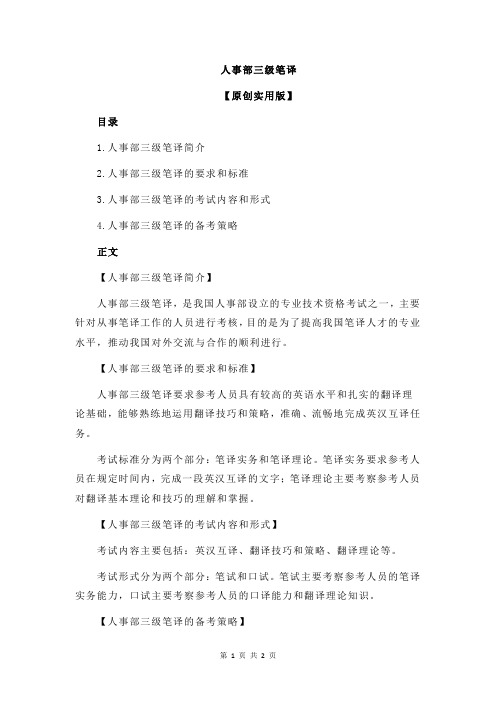
人事部三级笔译【原创实用版】目录1.人事部三级笔译简介2.人事部三级笔译的要求和标准3.人事部三级笔译的考试内容和形式4.人事部三级笔译的备考策略正文【人事部三级笔译简介】人事部三级笔译,是我国人事部设立的专业技术资格考试之一,主要针对从事笔译工作的人员进行考核,目的是为了提高我国笔译人才的专业水平,推动我国对外交流与合作的顺利进行。
【人事部三级笔译的要求和标准】人事部三级笔译要求参考人员具有较高的英语水平和扎实的翻译理论基础,能够熟练地运用翻译技巧和策略,准确、流畅地完成英汉互译任务。
考试标准分为两个部分:笔译实务和笔译理论。
笔译实务要求参考人员在规定时间内,完成一段英汉互译的文字;笔译理论主要考察参考人员对翻译基本理论和技巧的理解和掌握。
【人事部三级笔译的考试内容和形式】考试内容主要包括:英汉互译、翻译技巧和策略、翻译理论等。
考试形式分为两个部分:笔试和口试。
笔试主要考察参考人员的笔译实务能力,口试主要考察参考人员的口译能力和翻译理论知识。
【人事部三级笔译的备考策略】1.提高英语水平:要通过大量的阅读和听力训练,提高自己的英语水平,尤其是英语的理解和表达能力。
2.学习翻译理论:要系统学习翻译理论,了解并掌握各种翻译技巧和策略。
3.多做翻译练习:要多做英汉互译的练习,通过实践不断提高自己的翻译能力。
4.参加模拟考试:要参加模拟考试,模拟真实的考试环境,提高自己的应试能力。
5.注意时事新闻:要关注时事新闻,了解国内外大事,扩大自己的知识面,以便在考试中能够准确、流畅地完成翻译任务。
【结语】人事部三级笔译是我国对笔译人才进行考核的一种方式,具有较高的专业性和权威性。
全国人事部英语翻译三级考试样题(笔译实务)

全国翻译专业资格(水平)考试英语三级《笔译实务》试卷Section 1: English-Chinese Translation (50 points)Translate the following passage into Chinese.Freed by warming, waters once locked beneath ice are gnawing at coastal settlements around the Arctic Circle.In Bykovsky, a village of 457 residents at the tip of a fin-shaped peninsula on Russia’s northeast coast, the shoreline is collapsing, creeping closer and closer to houses and tanks of heating oil, at a rate of 15 to 18 feet, or 5 to 6 meters, a year. Eventually, homes will be lost as more ice melts each summer, and maybe all of Bykovsky, too.“It is practically all ice —permafrost —and it is thawing.” The 4 million Russian people who live north of the Arctic Circle are feeling the effects of warming in many ways. A changing climate presents new opportunities, but it also threatens their environment, the stability of their homes, and, for those whose traditions rely on the ice-bound wilderness, the preservation of their culture.A push to develop the North, quickened by the melting of the Arctic seas, carries its own rewards and dangers for people in the region. Discovery of vast petroleum fields in the Barents and Kara Seas has raised fears of catastrophic accidents as ships loaded with oil or liquefied gas churn through the fisheries off Scandinavia, headed for the eager markets of Europe and North America. Land that was untouched could be tainted by air and water pollution as generators, smokestacks and large vehicles sprout to support the growing energy industry.Coastal erosion is a problem in Alaska as well, forcing the United States to prepare to relocate several Inuit coastal villages at a projected cost of US$100 million or more for each one.Across the Arctic, indigenous tribes with cultural traditions shaped by centuries of living in extremes of cold and ice are noticing changes in weather and笔译实务(英语·三级)试卷第 1 页(共3 页)wildlife. They are trying to adapt, but it can be confounding.In Finnmark, the northernmost province of Norway, the Arctic landscape unfolds in late winter as an endless snowy plateau, silent but for the cries of the reindeer and the occasional whine of a snowmobile herding them.A changing Arctic is felt there, too, though in another way. “The reindeer are becoming unhappy,” said Issat Eir a, a 31-year-old reindeer herder.Few countries rival Norway when it comes to protecting the environment and preserving indigenous customs. The state has lavished its oil wealth on the region, and as a result Sami culture has enjoyed something of a renaissance.And yet no amount of government support can convince Eira that his livelihood, intractably entwined with the reindeer, is not about to change. Like a Texas cattleman he keeps the size of his herd secret. But he said warmer temperatures in fall and spring are melting the top layers of snow, which then refreeze as ice, making it harder for his reindeer to dig through to the lichen they eat.“The people who are making the decisions, they are living in the south and they are living in towns,” said Eira, sitting beside a birch fire inside his lavvu, a home made of reindeer hides. “They don’t mark the change of weather. It is only people who live in nature and get resources from nature who mark it.”Section 2: Chinese-English Translation (50 points)Translate the following passage into English.中国为种类繁多的菜肴感到十分自豪。
人事部三级笔译(CATTI)06.11英译汉真题

人事部三级笔译(CATTI)06.11英译汉真题人事部三级笔译(CATTI)2006.11英译汉真题For all the natural and man-made disasters of the past year, travelers seem more determined than ever to leave home.Never mind the tsunami devastation in Asia last December, the recent earthquake in Kashmir or the suicide bombings this year in London and Bali, among other places on or off the tourist trail. The number of leisure travelers visiting tourist destinations hit by trouble has in some cases bounced back to a level higher than before disaster struck.A"This new fast recovery of tourism we are observing is kind of strange," said John Koldowski, director for the Strategic Intelligence Center of the Bangkok-based Pacific Asia Travel Association. "It makes you think about the adage that any publicity is good publicity."It is still too soon to compile year-on-year statistics for the disasters of the past 12 months, but travel industry experts say that the broad trends are already clear. Leisure travel is expected to increase by nearly 5 percent this year, according to the World Tourism and Travel Council."Tourism and travel now seem to bounce back faster and higher each time there is an event of this sort," said Ufi Ibrahim,vice president of the London-based World T ourism and Travel Council. For London, where suicide bombers killed 56 and wounded 700 on July 8, she said, "It was almost as if people who stayed away after the bomb attack then decided to come back twice."Early indicators show that the same holds true for other disaster-struck destinations. Statistics compiled by the Pacific Asia Travel Association, for example, show that monthly visitor arrivals in Sri Lanka, where the Dec. 26, 2004, tsunami left more than 30,000 people dead or missing, were higher than one year earlier for every month from March through August of this year.A case commonly cited by travel professionals as an early example of the trend is Bali, where 202 people were killed in bombings targeting Western tourists in October 2002. Visitor arrivals plunged to 993,000 for the year after the bombing, but bounced back to 1.46 million in 2004, a level higher than the two years before the bomb, according to the Pacific Asia Travel Association.Even among Australians, who suffered the worst casualties in the Bali bombings, the number of Bali-bound visitors bounced back within two years to the highest level since 1998, according the Pacific Asia Travel Association. Bali was hit again this year by suicide bombers who killed 19 people in explosions at three restaurants.Visits are also on the upswing to post-tsunami Thailand, where the giant waves killed 5,400 and left more than 5,000missing.Although the tsunami killed more than 500 Swedes on the Thai resort island of Phuket, the largest number of any foreign nationality to die, Swedes are returning to the island in larger numbers than last year, according to My Travel Sweden, a Stockholm-based group that sends 600,000 tourists o verseas annually and claims a 28 percent market share for Sweden."We were confident that Thailand would eventually bounce back as a destination, but we didn"t think that this year it would come back even stronger than last year," said Joakim Eriksson, director of communication for My Travel Sweden. "We were very surprised because we really expected a significant decline." Eriksson said My Travel now expects a 5 percent increase in visitors to both Thailand and Sri Lanka this season compared with the same season last year. This behavior is a sharp change from the patterns of the 1990s, Eriksson said. "During the first Gulf war we saw a sharp drop in travel as a whole, and the same after Sept. 11," Eriksson said. "Now the main impact of terrorism or disasters is a change in destination."。
人事部三级笔译

人事部三级笔译摘要:1.人事部三级笔译概述2.人事部三级笔译的报考条件3.人事部三级笔译的考试内容4.人事部三级笔译的考试时间与地点5.人事部三级笔译的备考建议正文:【人事部三级笔译概述】人事部三级笔译,全称为全国翻译专业资格(水平)考试笔译人员资格考试(三级),是我国翻译行业的一项重要资格认证。
该考试旨在检验考生的翻译实践能力和基本素质,为社会输送合格的翻译人才。
【人事部三级笔译的报考条件】报考人事部三级笔译的条件相对宽松,凡具有中国国籍的公民,遵守国家法律法规,具有良好的品行和职业道德,具备一定的外语水平,均可报名参加考试。
具体外语水平要求因地区和年份有所不同,建议关注当地人事考试部门发布的最新报考条件。
【人事部三级笔译的考试内容】人事部三级笔译考试分为两部分:笔译实务和笔译综合能力。
1.笔译实务:主要测试考生的翻译实践能力,要求考生在规定时间内,将一篇外文文章翻译成中文,或者将一篇中文文章翻译成外文。
2.笔译综合能力:主要测试考生的基本语言知识和翻译理论知识,包括词汇、语法、句法、篇章结构等方面。
【人事部三级笔译的考试时间与地点】人事部三级笔译考试一般每年举行两次,分别在5 月和11 月。
具体考试时间和地点由当地人事考试部门安排,考生需关注官方发布的最新通知。
【人事部三级笔译的备考建议】1.提高语言能力:要想在笔译考试中取得好成绩,首先要提高自身的语言能力,包括听、说、读、写、译等方面。
2.学习翻译理论:了解翻译的基本原理和方法,掌握不同类型文本的翻译技巧。
3.积累词汇和表达:多阅读外文文章,积累词汇和地道表达,提高翻译质量。
4.多做练习:参加模拟考试,不断总结经验,提高自己的应试能力。
5.关注时事:关注国内外时事动态,以便在考试中能够熟练应对各类话题。
CATTI人事部翻译考试 三级笔译实务真题及答案2006.5
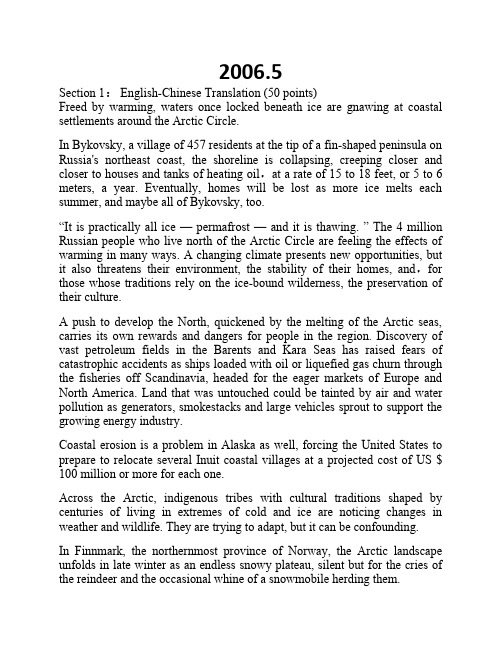
2006.5Section 1: English-Chinese Translation (50 points)Freed by warming, waters once locked beneath ice are gnawing at coastal settlements around the Arctic Circle.In Bykovsky, a village of 457 residents at the tip of a fin-shaped peninsula on Russia's northeast coast, the shoreline is collapsing, creeping closer and closer to houses and tanks of heating oil,at a rate of 15 to 18 feet, or 5 to 6 meters, a year. Eventually, homes will be lost as more ice melts each summer, and maybe all of Bykovsky, too.“It is practically all ice — permafrost — and it is thawing. ” The 4 million Russian people who live north of the Arctic Circle are feeling the effects of warming in many ways. A changing climate presents new opportunities, but it also threatens their environment, the stability of their homes, and,for those whose traditions rely on the ice-bound wilderness, the preservation of their culture.A push to develop the North, quickened by the melting of the Arctic seas, carries its own rewards and dangers for people in the region. Discovery of vast petroleum fields in the Barents and Kara Seas has raised fears of catastrophic accidents as ships loaded with oil or liquefied gas churn through the fisheries off Scandinavia, headed for the eager markets of Europe and North America. Land that was untouched could be tainted by air and water pollution as generators, smokestacks and large vehicles sprout to support the growing energy industry.Coastal erosion is a problem in Alaska as well, forcing the United States to prepare to relocate several Inuit coastal villages at a projected cost of US $ 100 million or more for each one.Across the Arctic, indigenous tribes with cultural traditions shaped by centuries of living in extremes of cold and ice are noticing changes in weather and wildlife. They are trying to adapt, but it can be confounding.In Finnmark, the northernmost province of Norway, the Arctic landscape unfolds in late winter as an endless snowy plateau, silent but for the cries of the reindeer and the occasional whine of a snowmobile herding them.A changing Arctic is felt there, too, though in another way. "The reindeer are becoming unhappy," said Issat Eira, a 31-year-old reindeer herder.Few countries rival Norway when it comes to protecting the environment and preserving indigenous customs. The state has lavished its oil wealth on the region, and as a result Sami culture has enjoyed something of a renaissance. And yet no amount of government support can convince Eira that his livelihood, intractably entwined with the reindeer, is not about to change. Like a Texas cattleman he keeps the size of his herd secret. But he said warmer temperatures in fall and spring are melting the top layers of snow,which then refreeze as ice, making it harder for his reindeer to dig through to the lichen they eat."The people who are making the decisions, they are living in the south and they are living in towns,”said Eira, sitting beside a birch fire inside his lavvu, a home made of reindeer hides. "They don't mark the change of weather. It is only people who live in nature and get resources from nature who mark it. ”Section 2: Chinese-English Translation (50 points)维护世界和平,促进共同发展,谋求合作共赢,是各国人民的共同愿望,也是不可抗拒的当今时代潮流。
catti二级三级笔译
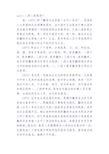
catti二级三级笔译?
答:CATTI即“翻译专业资格(水平)考试”,是国家人力资源和社会保障部委托,由中国外文出版发行事业局负责实施与管理的一项国家级职业资格考试,已纳入国家职业资格证书制度,是一项在中国实行的、统一的、面向全社会的翻译专业资格(水平)认证,是对参试人员口译或笔译方面双语互译能力和水平的评价与认定。
CATTI考试分7个语种,分别是英、日、法、阿拉伯、俄、德、西班牙等语种;四个等级,即:资深翻译;一级口译、笔译翻译;二级口译、笔译翻译;三级口译、笔译翻译。
其中资深翻译通过评审方式取得,一级口笔译翻译通过考试与评价相结合的方式取得,二、三级口笔译翻译通过考试方式取得。
CATTI考试是一项面向全社会的职业资格考试,凡是遵守中华人民共和国宪法和法律,恪守职业道德,具有一定外语水平的人员,不分年龄、学历、资历和身份,均可报名参加相应语种二、三级的考试。
获准在华就业的外籍人员及港、澳、台地区的专业人员,也可参加报名。
CATTI证书在全国范围内有效,是聘任翻译专业技术职务的必备条件之一。
根据国家人事部有关规定,翻译专业资格(水平)考试已经正式纳入国家职业资格证书制度,该考试在全国推开后,相应语种和级别的翻译专业技术职务评审工作不再进行。
对于申请参加相关语种和级别的口译或笔译翻译专业资格(水平)考试的考生来说,其报名条件并无特殊限制。
报名时,报考人员需携带本人身份证及复印件一份,近期免冠二寸彩色照片两张到指定报名点报名。
报考者在规定时间内报名,逾期不予补报。
人事部口译三级考试经验
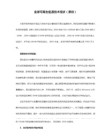
3.abundant=ample(enough and usually extra), plentiful(enough for people's needs and wants)1
4.stick=adhere, cling(hold on something tightly)1
5.neglect=ignore.(difference: neglect means someone has not paid enough attention to something; ignore means no attention.)
以上内容并不意味着其他大家喜闻乐见的字典(牛津、朗文、韦氏、科林斯、剑桥等)不好,只是这类英英或英汉双解字典对于笔译考试不对胃口,容易吃亏。
三:英文翻译&写作第一反应词替换表
英文翻译&写作第一反应词替换表英文翻译&写作第一反应词替换表
很多多同学经常把第一反应词翻来覆去的用,这样的后果就是:第一,写文章时用词的质量一直上不去;第二,一直缺乏对背过的单词的应用以及通过应用的语境理解和辨析。下面,我给大家列举了我们在写作常用的那些第一反应词的替换表,旨在告诉大家,要让自己的语言表达能力书面化,多样化。
3:dreadful, unfavorable, poor, adverse, ill (有害的)替换bad
4.(an army of, an ocean of, a sea of, a multitude of ,a host of, many, if not most)替换many.
Eg. Many individuals, if not most, harbor the idea that….同理 用most, if not all ,替换most.
人事部翻译考试三级笔译出题规律
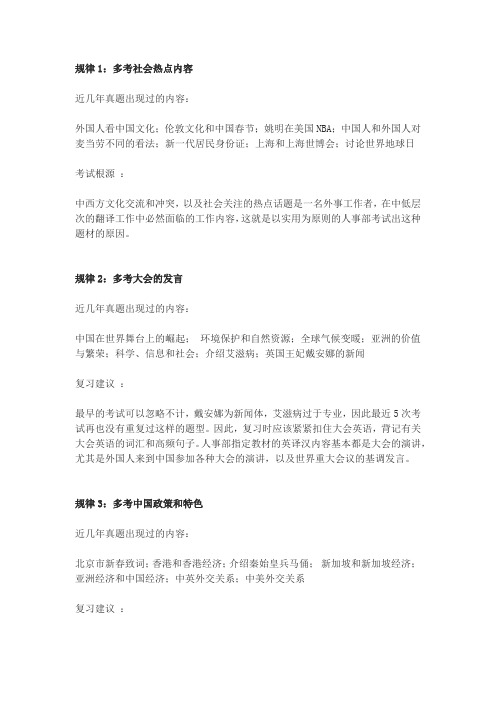
规律1:多考社会热点内容
近几年真题出现过的内容:
外国人看中国文化;伦敦文化和中国春节;姚明在美国NBA;中国人和外国人对麦当劳不同的看法;新一代居民身份证;上海和上海世博会;讨论世界地球日
考试根源:
中西方文化交流和冲突,以及社会关注的热点话题是一名外事工作者,在中低层次的翻译工作中必然面临的工作内容,这就是以实用为原则的人事部考试出这种题材的原因。
规律2:多考大会的发言
近几年真题出现过的内容:
中国在世界舞台上的崛起;环境保护和自然资源;全球气候变暖;亚洲的价值与繁荣;科学、信息和社会;介绍艾滋病;英国王妃戴安娜的新闻
复习建议:
最早的考试可以忽略不计,戴安娜为新闻体,艾滋病过于专业,因此最近5次考试再也没有重复过这样的题型。
因此,复习时应该紧紧扣住大会英语,背记有关大会英语的词汇和高频句子。
人事部指定教材的英译汉内容基本都是大会的演讲,尤其是外国人来到中国参加各种大会的演讲,以及世界重大会议的基调发言。
规律3:多考中国政策和特色
近几年真题出现过的内容:
北京市新春致词;香港和香港经济;介绍秦始皇兵马俑;新加坡和新加坡经济;亚洲经济和中国经济;中英外交关系;中美外交关系
复习建议:
这部分的内容最为稳定,复习时抓住指定教材中大而空的汉译英内容,这毕竟是三级考试,不必在语言的细枝末节方面或所谓的“地道”方面太计较。
三级笔译考试

三级笔译考试摘要:一、三级笔译考试简介1.考试定义2.考试目的3.考试等级二、考试内容与形式1.考试科目2.考试形式3.考试时间三、报考条件与程序1.报考条件2.报考程序四、考试大纲与备考资料1.考试大纲2.备考资料五、成绩查询与证书领取1.成绩查询2.证书领取六、考试意义与职业发展1.考试意义2.职业发展正文:三级笔译考试,即我国翻译专业资格(水平)考试中的一项,是我国对翻译专业人才能力的一种评价和认证。
该考试旨在选拔具备一定翻译水平和能力的人才,以满足我国对外交流与合作的需要。
一、三级笔译考试简介三级笔译考试分为两个等级:初级和中级。
初级适用于具备一定翻译基础和实践经验的人士,中级适用于已具备一定翻译能力和经验的人士。
通过考试,可获得相应级别的翻译资格证书。
二、考试内容与形式三级笔译考试包括两个科目:笔译综合能力和笔译实务。
笔译综合能力主要测试考生的翻译基础知识、语言表达能力和翻译策略;笔译实务则测试考生的实际翻译能力。
考试形式为闭卷笔试,考生需在规定时间内完成试题。
三、报考条件与程序报考三级笔译考试需具备以下条件:遵纪守法、具备一定外语水平、具备一定翻译实践经验。
报考程序包括:网上报名、缴费、打印准考证、参加考试。
四、考试大纲与备考资料考试大纲详细列出了各级别考试的要求、内容、题型及分值分布。
备考资料包括官方发布的教材、辅导书籍、历年真题等。
五、成绩查询与证书领取考试结束后,考生可通过官网查询成绩。
成绩合格者,可按规定领取翻译资格证书。
六、考试意义与职业发展三级笔译考试是对考生翻译能力的权威认证,有助于提高个人综合素质和职业竞争力。
2005-2009人事部三级笔译真题
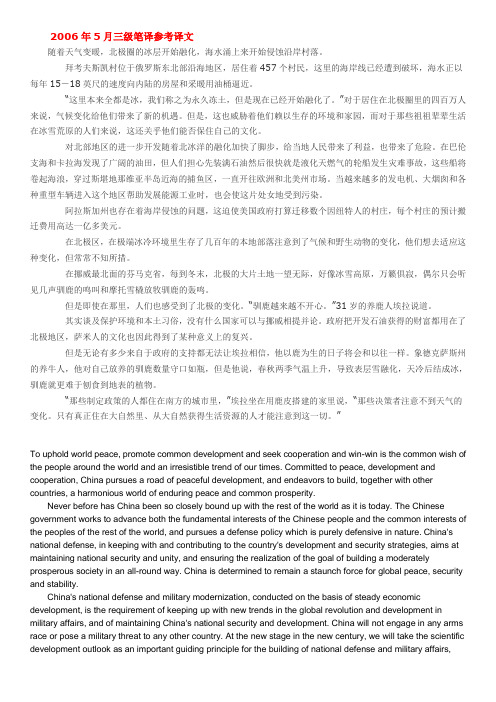
2006年5月三级笔译参考译文随着天气变暖,北极圈的冰层开始融化,海水涌上来开始侵蚀沿岸村落。
拜考夫斯凯村位于俄罗斯东北部沿海地区,居住着457个村民,这里的海岸线已经遭到破坏,海水正以每年15-18英尺的速度向内陆的房屋和采暖用油桶逼近。
“这里本来全都是冰,我们称之为永久冻土,但是现在已经开始融化了。
”对于居住在北极圈里的四百万人来说,气候变化给他们带来了新的机遇。
但是,这也威胁着他们赖以生存的环境和家园,而对于那些祖祖辈辈生活在冰雪荒原的人们来说,这还关乎他们能否保住自己的文化。
对北部地区的进一步开发随着北冰洋的融化加快了脚步,给当地人民带来了利益,也带来了危险。
在巴伦支海和卡拉海发现了广阔的油田,但人们担心先装满石油然后很快就是液化天燃气的轮船发生灾难事故,这些船将卷起海浪,穿过斯堪地那维亚半岛近海的捕鱼区,一直开往欧洲和北美州市场。
当越来越多的发电机、大烟囱和各种重型车辆进入这个地区帮助发展能源工业时,也会使这片处女地受到污染。
阿拉斯加州也存在着海岸侵蚀的问题,这迫使美国政府打算迁移数个因纽特人的村庄,每个村庄的预计搬迁费用高达一亿多美元。
在北极区,在极端冰冷环境里生存了几百年的本地部落注意到了气候和野生动物的变化,他们想去适应这种变化,但常常不知所措。
在挪威最北面的芬马克省,每到冬末,北极的大片土地一望无际,好像冰雪高原,万籁俱寂,偶尔只会听见几声驯鹿的鸣叫和摩托雪橇放牧驯鹿的轰鸣。
但是即使在那里,人们也感受到了北极的变化。
“驯鹿越来越不开心。
”31岁的养鹿人埃拉说道。
其实谈及保护环境和本土习俗,没有什么国家可以与挪威相提并论。
政府把开发石油获得的财富都用在了北极地区,萨米人的文化也因此得到了某种意义上的复兴。
但是无论有多少来自于政府的支持都无法让埃拉相信,他以鹿为生的日子将会和以往一样。
象德克萨斯州的养牛人,他对自己放养的驯鹿数量守口如瓶,但是他说,春秋两季气温上升,导致表层雪融化,天冷后结成冰,驯鹿就更难于刨食到地表的植物。
人事部CATTI三级笔译考试的8条锦囊妙计

1.字典越大才越好实务考试可带两本字典。
英译汉最大的字典是译文出版社出的《英汉大辞典》,收词20万,录有大量人名、地名等专有名词。
汉译英最大的字典是外研社出的《新世纪汉英大词典》,收词14万,收录大量新词和例句。
普通牛津、朗文双解词典一般收词不超过8万,且没有专有名词,普通用汉英词典缺少最新词汇,而且例句少,用法少。
英英字典不要带。
考试情景1:2006年5月笔译实务考试英译汉Scandinavia(斯堪的纳维亚半岛),一般牛津和朗文双解字典因不收地名,考试时无法查到。
考试情景2:2005年5月笔译实务考试汉译英"西藏地处世界屋脊","屋脊"在一般汉英字典里只可查到"ridge",在大型词典里会有两解"ridge"和"roof",更会有例句:"帕米尔高原地处世界屋脊",因此得到标准答案:"on the roof of the world"。
考试情景3:2005年5月笔译实务考试英译汉rye,英英字典的解释为a type of grain, the seeds of which are used to make flour or whisky or to feed animals。
想十分钟也想不明白是什么粮食,不如英汉字典-"黑麦"那么干脆。
考试情景4:为了在分秒必争的考试中节约时间,请在两本字典上按照字母顺序作标签,这样一翻就到位了。
2.事先一定要踩点考前一周电脑打印准考证,准考证上有考试地点和注意事项,应认真阅读。
如2006年5月北京地区考生的三级笔译考试地点为:北京信息职业技术学院本部(朝阳区芳园西路5号)。
考试情景5:某考生于考前一天在互联网上查找到相应的公交线路,乘车前往考点,估算了第二天所需时间。
根据准考证的要求,考试提前15分钟入场,迟到半小时不得入内。
2012年下半年-人事部三级笔译-真题

三级笔译:1. 英译汉:节选自The Boston Globe,原文标题为:Connected by Dickens?FOR MORE than 30 years, I have been wondering about L.R. Generson. On one of our first Christmases together, my husband gave me a complete set of Dickens. There were 20 volumes, bound in gray cloth with black corners, old but in good condition. Stamped on the flyleaf of each volume, in faded block letters, was the name of the previous owner:“L.R. Generson, M.D., Bronx, NY.’’That Dickens set is one of the best presents anyone has ever given me. A couple of the books are still pristine, but others -“Bleak House,’’ “David Copperfield,’’ and especially “Great Expectations’’ - have been read and re-read almost to pieces. Over the years, Pip and Estella and Magwitch have kept me company. So have Lady Dedlock, Steerforth and Peggotty, the Cratchits and the Pecksniffs and the Veneerings. And so, in his silent enigmatic way, has L.R. Generson.Did he love the books as much as I do? Who was he? On a whim, I Googled him. There wasn’t much - a single mention on a veterans’ website of a World War II captain named Leonard Generson. But I did find a Dr. Richard Generson, an oral surgeon living in New Jersey. Since Generson is not a common name, I decided to write to him.Dr. Generson was kind enough to write back. He told me that his father, Leonard Richard Generson, was born in 1909. He lived in New York City but went to medical school in Basel,Switzerland. He spoke 10 languages fluently. As an obstetrician and gynecologist, he opened a practice in the Bronx shortly before World War II. His son described him as “an extremely patriotic individual’’; right after Pearl Harbor he closed his practice and enlisted. He served throughout the war as a general surgeon with an airborne special forces unit in Europe, where he became one of the war’s most highly decorated physicians.The list of his decorations reflects his ordeals and his courage: multiple Purple Hearts, the Bronze Star with “V’’ for valor, the Silver Star, and also the Cross of War, an extremely high honor from the government of France. After the war, he remained in the Army Reserve and attained the rank of full colonel, while also continuing his medical practice in New York. “He was a very dedicated physician who had a large patient following,’’ his son wrote.Leonard Generson’s son didn’t remember the Dickens set, though he told me that there were always a lot of novels in the house. His mother probably “cleaned house’’ after his father’s death in 1977 - the same year my husband bought the set in a used book store.I found this letter very moving, with its brief portrait of an intelligent, brave man and his life of service. At the same time, it made me question my presumption that somehow L.R. Generson and I were connected because we’d owned the same set of books. The letter both told me a little about him, and told me that I would never really know anything about him - and why should I? His son must have been startled to hear from a stranger on such a fragile pretext. What had Ibeen thinking?One possible, and only somewhat facetious, answer is that I’ve read too much Dickens. In the world of a Dickens novel, everything is connected to everything else. Orphans find families. Lovers are joined (or parted and morally strengthened). Ancient mysteries are solved and old scores are settled. Questions are answered. Stories end.Dickens’s cluttered network of connected lives brilliantly exaggerates something that is true of all of us. We want to impose order through telling stories, maybe because there is so much we don’t know about our own stories and the stories of those around us.Leonard Generson’s life touched mine only lightly, through the coincidence of a set of books. But there are other lives he touched more deeply. The next time I read a Dickens novel, I will think of him and his military service and his 10 languages. And I will think of the hundreds of babies he must have delivered, who are now in the middle of their own lives and their own stories.2. 汉译英:得而达Delta 水龙头公司简介总部位于美国印第安纳州的得而达(Delta)水龙头公司是美国一家上市公司Masco集团的核心企业。
CATTI人事部翻译考试 三级笔译实务真题及答案2010.5
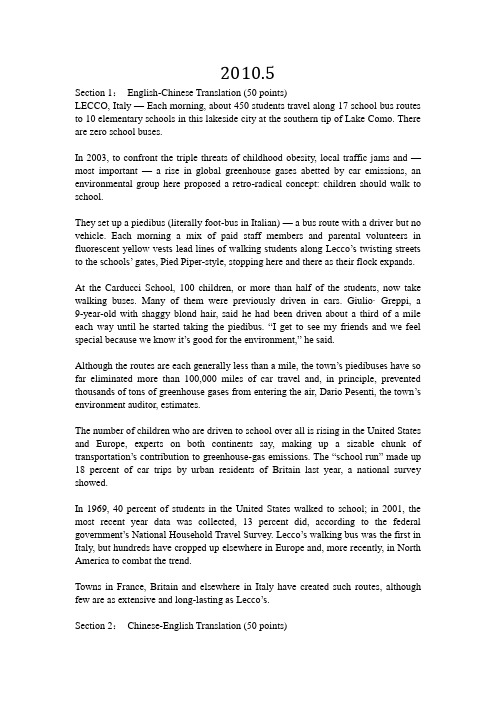
2010.5Section 1:English-Chinese Translation (50 points)LECCO, Italy — Each morning, about 450 students travel along 17 school bus routes to 10 elementary schools in this lakeside city at the southern tip of Lake Como. There are zero school buses.In 2003, to confront the triple threats of childhood obesity, local traffic jams and —most important —a rise in global greenhouse gases abetted by car emissions, an environmental group here proposed a retro-radical concept: children should walk to school.They set up a piedibus (literally foot-bus in Italian) — a bus route with a driver but no vehicle. Each morning a mix of paid staff members and parental volunteers in fluorescent yellow vests lead lines of walking students along Lecco’s twisting streets to t he schools’ gates, Pied Piper-style, stopping here and there as their flock expands.At the Carducci School, 100 children, or more than half of the students, now take walking buses. Many of them were previously driven in cars. Giulio·Greppi, a 9-year-old with shaggy blond hair, said he had been driven about a third of a mile each way until he started taking the piedibus. “I get to see my friends and we feel special because we know it’s good for the environment,” he said.Although the routes are each gene rally less than a mile, the town’s piedibuses have so far eliminated more than 100,000 miles of car travel and, in principle, prevented thousands of tons of greenhouse gases from entering the air, Dario Pesenti, the town’s environment auditor, estimates.The number of children who are driven to school over all is rising in the United States and Europe, experts on both continents say, making up a sizable chunk of transportation’s contribution to greenhouse-gas emissions. The “school run” made up 18 percent of car trips by urban residents of Britain last year, a national survey showed.In 1969, 40 percent of students in the United States walked to school; in 2001, the most recent year data was collected, 13 percent did, according to the federal government’s National Household Travel Survey. Lecco’s walking bus was the first in Italy, but hundreds have cropped up elsewhere in Europe and, more recently, in North America to combat the trend.Towns in France, Britain and elsewhere in Italy have created such routes, although few are as extensive and long-lasting as Lecco’s.Section 2:Chinese-English Translation (50 points)全球气候变化深刻影响着人类生存和发展,是各国共同面临的重大挑战。
人事部三级笔译

人事部三级笔译(CATTI)2007.11英译汉真题One of the biggest decisions Andy Blevins has ever made, and one of the few he now regrets, never seemed like much of a decision at all. It just felt like the natural thing to do.In the summer of 1995, he was moving boxes of soup cans, paper towels and dog food across the floor of a supermarket warehouse, one of the biggest buildings here in southwest Virginia. The heat was brutal. The job had sounded impossible when he arrived fresh off his first year of college, looking to make some summer money, still a skinny teenager with sandy blond hair and a narrow, freckled face.But hard work done well was something he understood, even if he was the first college boy in his family. Soon he was making bonuses on top of his $6.75 an hour, more money than either of his parents made. His girlfriend was around, and so were his hometown buddies. Andy acted more outgoing with them, more relaxed. People in Chilhowie noticed that.It was just about the perfect summer. So the thought crossed his mind: maybe it did not have to end. Maybe he would take a break from college and keep working. He had been getting C's and D's, and college never felt like home, anyway."I enjoyed working hard, getting the job done, getting a paycheck," Mr. Blevins recalled. "I just knew I didn't want to quit."So he quit college instead, and with that, Andy Blevins joined one of the largest and fastest-growing groups of young adults in America. He became a college dropout, though nongraduate may be the more precise term.Many people like him plan to return to get their degrees, even if few actually do. Almost one in three Americans in their mid-20's now fall into this group, up from one in five in the late 1960's, when the Census Bureau began keeping such data. Most come from poor and working-class families.That gap had grown over recent years. "We need to recognize that the most serious domestic problem in the United States today is the widening gap between the children of the rich and the children of the poor," Lawrence H. Summers, the president of Harvard, said last year when announcing that Harvard would give full scholarships to all its lowest-income students. "And education is the most powerful weapon we have to address that problem."Andy Blevins says that he too knows the importance of a degree. Ten years after trading college for the warehouse, Mr. Blevins, 29, spends his days at the same supermarket company. He has worked his way up to produce buyer, earning $35,000 a year with health benefits and a 401(k) plan. He is on a path typical for someone who attended college without getting a four-year degree. Men in their early 40's in this category made an average of $42,000 in 2000. Those with a four-year degree made $65,000.Mr. Blevins says he has many reasons to be happy. He lives with his wife, Karla, and their year-old son, Lucas, in a small blue-and-yellow house in the middle of a stunningly picturesque Appalachian valley."Looking back, I wish I had gotten that degree," Mr. Blevins said in his soft-spoken lilt. "Four years seemed like a thousand years then. But I wish I would have just put in my four years."Why so many low-income students fall from the college ranks is a question without a simple answer. Many high schools do a poor job of preparing teenagers for college. Tuition bills scare some students from even applying and leave others with years of debt. To Mr. Blevins, like many other students of limited means, every week of going to classes seemed like another week of losing money ."The system makes a false promise to students," said John T. Casteen III, the president of the University of Virginia, himself the son of a Virginia shipyard worker.One of the biggest decisions Andy Blevins has ever made, and one of the few he now regrets, never seemed like much of a decision at all. It just felt like the natural thing to do.安迪布莱文思曾做过的最大的、同时也是他现在极少为之后悔的决定之一,看起来一点也不像个决定。
人事部三级笔译练习册系列译文评析一------旧金山和西藏两篇 带原文和改译

• 一名导游对记者说:“我必须来这里,这 里有钱赚啊。” • “I had to come here,” a tour guide told me during my visit to Tibet this summer. “This is where I can make money.”
• 这股旅游热潮还只是刚刚开始。尽管西藏2004年 接待游客约为120万之多,但一位官员预计,到 2020年,西藏游客可能增加到1200万。 • This tourism boom ___, ___is only a beginning. Though in 2004 Tibet received some 1.2 million tourists, an official estimated that 12 million visitors may come by 2020. • My version: • As estimated by an official, the visitor’s number will have climbed to 12 million by 2020 though it is now some 1.2 million.
• 然而正当更多外国游客考虑进藏旅游,西藏正在 变得更加舒适,更加便于自助游客进出,而且具 备了高档的住宿条件。 • Yet even as more foreigners consider visiting, Tibet is becoming more comfortable, with easier access for independent travelers and higherend/deluxe accommodations. • 我的改译: • More comfortable tourist environment, easier access for self-help travelers and higher-end accommodations are reassuring those foreigners who just put Tibetan Tourism onto their agenda.
人事部三级笔译

人事部三级笔译概述人事部三级笔译是指在人事部门中从事笔译工作的职位级别。
这个级别的笔译人员通常具有较高的翻译能力和专业知识,能够胜任较为复杂的翻译任务,并且在人事部门中扮演重要角色,负责处理与人员招聘、培训、管理等相关的文件和文档的翻译工作。
职责和要求职责1.负责对人事部门相关文件和文档的翻译工作,包括但不限于招聘广告、招聘需求、招聘策略、培训材料、员工手册等。
2.确保翻译准确、质量高,并对翻译文稿进行校对和修改,以确保符合专业标准和组织要求。
3.根据人事部门的需要,参与会议翻译,包括会议记录、会议纪要等文件的翻译工作。
4.协助人事部门进行外籍员工的汉语口译工作,包括面试翻译、培训翻译等。
要求1.具备扎实的语言基础,包括英语或其他外语的熟练掌握。
2.以中文为母语,并具备优秀的中文写作和口语表达能力。
3.具备一定的心理素质和团队合作精神,能够承受较高的工作压力。
4.具备良好的时间管理和组织能力,能够高效完成翻译任务。
5.具备一定的人事管理知识和背景,能够理解和处理人事部门相关的专业术语和内容。
工作范围人事部三级笔译的工作范围主要涵盖以下几个方面:1.招聘翻译:人事部门经常需要发布招聘广告、招聘需求和招聘策略等文件,由人事部三级笔译完成翻译工作,以确保招聘信息准确传达。
2.培训翻译:人事部门进行培训时,需要准备培训材料,如培训手册、PPT等,人事部三级笔译需将这些材料翻译成相应的外语版本,以便外籍员工能够理解和掌握培训内容。
3.会议翻译:人事部门组织的会议需要具备多语种翻译,人事部三级笔译会负责会议记录、会议纪要等文件的翻译工作,以方便与会人员对会议内容的了解和回顾。
4.口译工作:在人事部门,经常需要面试外籍员工或进行一些外籍员工的培训工作,人事部三级笔译将承担对外籍员工的汉语口译工作,以方便沟通和交流。
学习和发展人事部三级笔译岗位是一个需要不断学习和发展的职位。
为了不断提升自己的翻译能力和专业水平,以下是一些建议:1.继续深造:参加相关的语言培训课程,提升外语水平,并且可以考取相关的翻译资格证书,如CATTI(中国翻译资格考试)等。
英语三级笔译考试大纲
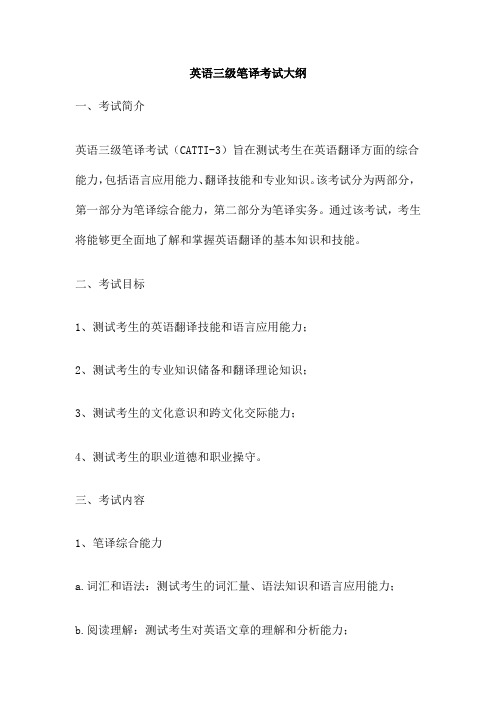
英语三级笔译考试大纲一、考试简介英语三级笔译考试(CATTI-3)旨在测试考生在英语翻译方面的综合能力,包括语言应用能力、翻译技能和专业知识。
该考试分为两部分,第一部分为笔译综合能力,第二部分为笔译实务。
通过该考试,考生将能够更全面地了解和掌握英语翻译的基本知识和技能。
二、考试目标1、测试考生的英语翻译技能和语言应用能力;2、测试考生的专业知识储备和翻译理论知识;3、测试考生的文化意识和跨文化交际能力;4、测试考生的职业道德和职业操守。
三、考试内容1、笔译综合能力a.词汇和语法:测试考生的词汇量、语法知识和语言应用能力;b.阅读理解:测试考生对英语文章的理解和分析能力;c.完形填空:测试考生对英语短文的理解和判断能力;d.听力理解:测试考生对英语听力的理解和判断能力。
2、笔译实务a.英译汉:测试考生对英语文章的翻译能力和表达能力;b.汉译英:测试考生对中文文章的翻译能力和表达能力。
四、考试形式和评分标准1、考试形式:考试采用闭卷、计算机化考试方式,考试时间为180分钟。
其中,笔译综合能力的考试时间为90分钟,笔译实务的考试时间为90分钟。
2、评分标准:笔译综合能力的评分标准包括词汇和语法、阅读理解、完形填空、听力理解等方面;笔译实务的评分标准包括翻译准确度、语言表达流畅度、词汇运用得当度等方面。
五、考试时间和地点1、考试时间:每年5月和11月的第二个周末进行考试。
具体时间请官方网站公告。
2、考试地点:在全国范围内设置考点,考生可选择就近的考点进行考试。
具体考点设置请官方网站公告。
六、备考建议1、加强英语词汇和语法知识的学习,提高语言应用能力;2、多做阅读理解和完形填空的练习,提高对英语文章的理解和分析能力;3、加强听力训练,提高英语听力理解能力;4、多进行英译汉和汉译英的练习,提高翻译技能和表达能力;5、熟悉CATTI-3考试大纲和评分标准,了解考试要求和趋势。
英语二级笔译考试大纲一、考试简介英语二级笔译考试,全称为全国翻译专业资格(水平)考试英语二级笔译考试,是由国家人力资源和社会保障部组织实施的一项国家级外语考试。
- 1、下载文档前请自行甄别文档内容的完整性,平台不提供额外的编辑、内容补充、找答案等附加服务。
- 2、"仅部分预览"的文档,不可在线预览部分如存在完整性等问题,可反馈申请退款(可完整预览的文档不适用该条件!)。
- 3、如文档侵犯您的权益,请联系客服反馈,我们会尽快为您处理(人工客服工作时间:9:00-18:30)。
卡里·福勒是一家负责管理种子库的非营利性组织全球作物多样性托管会的总裁,他说:“我们是在‘9·11’事件之后、尤其是卡特里娜飓风之后,开始有这个构想的。” 他还说:“每个人都在问:为什么事先不作好迎接飓风的准备呢?我们明明知道会发生飓风的。”
8.“Well, we are losing biodiversity every day — it’s a kind of drip, drip, drip. It’s also inevitable. We need to do something about it.”
他指出:“喏,我们每天都在损失生物多样性——一点一滴地在损失。这种损失没有止步的迹象,我们必须为此做点什么。”
9.This week the urgency of the problem was underscored as wheat prices rose to record highs and wheat stores dropped to the lowest level in 35 years. A series of droughts and new diseases cut wheat production in many parts of the world. “The erosion of plants’ genetic resources is really going fast,” said Dr. Rony Swennen, head of the division of crop biotechnology at the Catholic University of Leuven in Belgium, who has preserved half of the world’s 1,200 banana types. “We’re at a critical moment and if we don’t act fast, we’re going to lose a lot of plants that we may need.”
本周,作为这种不懈努力的旗舰机构,“全球种子地库”接收了首批数百万种的种子。该地库建于北极的一座白雪皑皑的大山之中,其目标是储存和保护世界各地收藏的各类种子样本。
3.As of Thursday, thousands of neatly stacked and labeled gray boxes of seeds — peas from Nigeria, corn from Mexico — reside in this glazed cavelike structure, forming a sort of backup hard drive, in case natural disasters or human errors erase the seeds from the outside world.
已于2004年获得批准的联合国国际植物基因资源条约创建了一个正式的全球网络,旨在对种子进行储存和共享并对其遗传特征进行研究。去年,有成千上万的新种子在其数据库安家落户。
11.A system of plant banks could be crucial in responding to climate crises since it could identify genetic material and plant strains better able to cope with a changed environment.
本周,由于小麦价格上升到最高纪录水平和小麦储存量下滑到35年来最低水平,更加突出了这个问题的紧迫性。由于一连串的干旱及新的疾病,世界很多地方的小麦产量下降。罗尼·斯文奈恩博士现任比利时鲁汶天主教大学作物生物技术部主任,他保存了世界上1200种香蕉种的一半以上。斯文奈恩博士说:“植物基因资源正在受到快速侵蚀。”他还指出:“我们正处于关键时刻,如果不迅速采取行动,我们将失去很多我们需要的植物物种。”
10.The United Nations International Treaty on Plant Genetic Resources, ratified in 2004, created a formal global network for banking and sharing seeds, as well as for studying their genetic traits. Last year, its database received thousands of new seeds.
多年来,很多庞杂的种子库网络一直以随意的方式收集种子和苗芽。例如,墨西哥的实验室收藏玉米种,尼日利亚的实验室收藏木薯种。现在,正对这些分散的努力进行亟需的整合和系统化操作。之所以可以这样做,部分原因是储存植物基因技术的更新,部分原因是气候变化的警钟继续长鸣及其对世界粮食产量的影响。
7.“We started thinking about this post-9/11 and on the heels of Hurricane Katrina,” said Cary Fowler, president of the Global Crop Diversity Trust, a nonprofit group that runs the vault. “Everyone was saying, why didn’t anyone prepare for a hurricane before? We knew it was going to happen.
通往种子地库的入口隧道,位于永冻带下约500英尺处,其设计旨在防御爆炸和地震。自动化数字监控系统用于控制温度并提供类似导弹发射井或福特诺克斯军事基地的安全保障。任何人都不单独拥有进入种子库的全部密码。
5.The Global Vault is part of a broader effort to gather and systematize information about plants and their genes, which climate change experts say may indeed prove more valuable than gold. In Leuven, Belgium, scientists are scouring the world for banana samples and preserving their shoots in liquid nitrogen before they become extinct. A similar effort is under way in France on coffee plants. A number of plants, most from the tropics, do not produce seeds that can be stored.
目前,世界上很多人士致力于收集种子及其种子基因的信息并使之系统化,全球种子地库是这种全球性努力的的一个缩影。气候变化专家称,这些信息要比金子还要贵重。在比利时的鲁汶,科学家正在搜集世界上的香蕉样本并将香蕉芽保存在液体氮中,以防其灭绝。法国也正在进行类似的努力,保护咖啡物种。很多植物,大多数是来自热带地区的植物,无法通过种子繁殖,不能产生可供储存的种子。
由于植物库系统能够识别出那些对环境变化适应能力较强的基因物质和植物种类,因而这种系统能在应对气候危机中发挥至关重要的作用。
12.Here at the Global Vault, hundreds of gray boxes containing seeds from places ranging from Syria to Mexico were moved this week into a freezing vault to be placed in suspended animation. They harbor a vast range of qualities, like the ability to withstand drier, warmer climate.
1.LONGYEARBYEN, Norway — With plant species disappearing at an alarming rate, scientists and governments are creating a global network of plant banks to store seeds and sprouts, precious genetic resources that may be needed for man to adapt the world’s food supply to climate change. 我要年薪百万
截至周四,成千上万个堆放整齐且贴有标签的灰色种盒在上釉的洞穴式结构中安家落户,如尼日利亚的豌豆、墨西哥的玉米。这些盒子就如已经备份了的电脑硬盘,以防世界上的植物物种会因自然灾害和人为破坏而消失。
